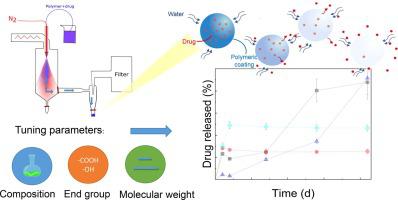当前位置:
X-MOL 学术
›
Eur. Polym. J.
›
论文详情
Our official English website, www.x-mol.net, welcomes your
feedback! (Note: you will need to create a separate account there.)
Encapsulation of Octenidine Hydrochloride into Bioresorbable Polyesters for Extended Antimicrobial Activity
European Polymer Journal ( IF 5.8 ) Pub Date : 2020-09-01 , DOI: 10.1016/j.eurpolymj.2020.109987 Antoine Klaue , Matteo Maraldi , Camilla Piviali , Davide Moscatelli , Massimo Morbidelli
European Polymer Journal ( IF 5.8 ) Pub Date : 2020-09-01 , DOI: 10.1016/j.eurpolymj.2020.109987 Antoine Klaue , Matteo Maraldi , Camilla Piviali , Davide Moscatelli , Massimo Morbidelli

|
Abstract Nosocomial infections remain a serious threat even for patients of highly industrialized countries. These infections occur on surgical sites and wounds, on catheter entry sites, tubes and other indwelling devices. Medical devices providing local antiseptic action over an extended time period represent an opportunity to prevent such infections. One way to achieve this goal is the encapsulation of active molecules into bioresorbable polymer microparticles, which can locally release the compound of interest along a tunable time span depending on the polymer characteristic. In this work, spray drying is used to encapsulate the broad band antiseptic octenidine hydrochloride into a set of poly( d , l -lactide) (PDLLA) and poly( d , l -lactide-co-glycolide) (PLGA) carrier materials with different molecular weights and chain end-groups, forming redispersable powders. It is demonstrated that the carrier materials bearing acid end-groups provide a significantly larger entrapment efficacy comparing with their ester counterparts independently of carrier composition and molecular weight. The quantitative understanding of the release mechanism allows guiding the selection of suitable encapsulating polyesters to tune initial burst and long time release of a given drug. Finally, it is demonstrated on cultures of Staphylococcus epidermidis that the encapsulated and subsequently released OHC has conserved its antiseptic activity, which supports the potential applicability of the approach.
中文翻译:

将盐酸奥替尼啶封装到生物可吸收聚酯中以延长抗菌活性
摘要 即使对于高度工业化国家的患者,医院感染仍然是一个严重的威胁。这些感染发生在手术部位和伤口、导管入口部位、导管和其他留置装置上。在较长时间内提供局部防腐作用的医疗器械代表了预防此类感染的机会。实现这一目标的一种方法是将活性分子封装到生物可吸收聚合物微粒中,这可以根据聚合物特性在可调节的时间跨度内局部释放感兴趣的化合物。在这项工作中,喷雾干燥用于将宽带防腐剂奥替尼定盐酸盐封装到一组聚(d,l-丙交酯)(PDLLA)和聚(d,l-丙交酯-共-乙交酯)(PLGA)载体材料中不同的分子量和链端基,形成可再分散的粉末。结果表明,与载体组成和分子量无关的酯对应物相比,带有酸端基的载体材料提供了显着更大的截留效率。对释放机制的定量理解允许指导选择合适的封装聚酯来调整给定药物的初始爆发和长时间释放。最后,在表皮葡萄球菌的培养物中证明,封装后释放的 OHC 保留了其防腐活性,这支持了该方法的潜在适用性。结果表明,与载体组成和分子量无关的酯对应物相比,带有酸端基的载体材料提供了显着更大的截留效率。对释放机制的定量理解允许指导选择合适的封装聚酯来调整给定药物的初始爆发和长时间释放。最后,在表皮葡萄球菌的培养物中证明,封装后释放的 OHC 保留了其防腐活性,这支持了该方法的潜在适用性。结果表明,与载体组成和分子量无关的酯对应物相比,带有酸端基的载体材料提供了显着更大的截留效率。对释放机制的定量理解允许指导选择合适的封装聚酯来调整给定药物的初始爆发和长时间释放。最后,在表皮葡萄球菌的培养物中证明,封装后释放的 OHC 保留了其防腐活性,这支持了该方法的潜在适用性。
更新日期:2020-09-01
中文翻译:

将盐酸奥替尼啶封装到生物可吸收聚酯中以延长抗菌活性
摘要 即使对于高度工业化国家的患者,医院感染仍然是一个严重的威胁。这些感染发生在手术部位和伤口、导管入口部位、导管和其他留置装置上。在较长时间内提供局部防腐作用的医疗器械代表了预防此类感染的机会。实现这一目标的一种方法是将活性分子封装到生物可吸收聚合物微粒中,这可以根据聚合物特性在可调节的时间跨度内局部释放感兴趣的化合物。在这项工作中,喷雾干燥用于将宽带防腐剂奥替尼定盐酸盐封装到一组聚(d,l-丙交酯)(PDLLA)和聚(d,l-丙交酯-共-乙交酯)(PLGA)载体材料中不同的分子量和链端基,形成可再分散的粉末。结果表明,与载体组成和分子量无关的酯对应物相比,带有酸端基的载体材料提供了显着更大的截留效率。对释放机制的定量理解允许指导选择合适的封装聚酯来调整给定药物的初始爆发和长时间释放。最后,在表皮葡萄球菌的培养物中证明,封装后释放的 OHC 保留了其防腐活性,这支持了该方法的潜在适用性。结果表明,与载体组成和分子量无关的酯对应物相比,带有酸端基的载体材料提供了显着更大的截留效率。对释放机制的定量理解允许指导选择合适的封装聚酯来调整给定药物的初始爆发和长时间释放。最后,在表皮葡萄球菌的培养物中证明,封装后释放的 OHC 保留了其防腐活性,这支持了该方法的潜在适用性。结果表明,与载体组成和分子量无关的酯对应物相比,带有酸端基的载体材料提供了显着更大的截留效率。对释放机制的定量理解允许指导选择合适的封装聚酯来调整给定药物的初始爆发和长时间释放。最后,在表皮葡萄球菌的培养物中证明,封装后释放的 OHC 保留了其防腐活性,这支持了该方法的潜在适用性。











































 京公网安备 11010802027423号
京公网安备 11010802027423号